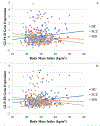The effect of body mass index on glucagon-like peptide receptor gene expression in the post mortem brain from individuals with mood and psychotic disorders
- PMID: 30409537
- PMCID: PMC6368894
- DOI: 10.1016/j.euroneuro.2018.10.007
The effect of body mass index on glucagon-like peptide receptor gene expression in the post mortem brain from individuals with mood and psychotic disorders
Abstract
There is an increasing interest in the putative role of glucagon-like peptide 1 receptor (GLP-1R) agonists as novel therapeutic agents for mental disorders. Herein, we investigated the expressions of GLP-1R and GLP-2R genes, and its relationship with body mass index (BMI), in the post-mortem brain tissue of patients with mood (MD) and psychotic disorders. Brain samples were localized to the dorsolateral prefrontal cortex (dlPFC) (n = 459) and hippocampus (n = 378). After adjustment for age, sex, ethnicity, post-mortem interval (PMI) and BMI, we observed significant differences, between healthy controls and MD subjects, in GLP-1R and GLP-2R gene expression in the dlPFC (β = 1.504, p = 0.004; and β = 1.305, p = 0.011, respectively); whereas in the hippocampus, only GLP-1R expression was significantly associated with MD (β = -1.28, p = 0.029). No significant differences were found in relation to schizophrenia. In addition, we observed a moderating effect of MD diagnosis on the associations between BMI, GLP-1R and GLP-2R expression values in the dlPFC (β = -0.05, p = 0.003; and β = -0.04, p = 0.004, respectively). There was a similar moderating effect for GLP-1R in the hippocampus (β = 0.043, 95% CI 0.003; 0.08 p = 0.03), but in an opposite direction than observed in the dlPFC. This is the first evidence of abnormal gene expression of GLP-1R and GLP-2R in postmortem brain of individuals with MD, providing a rationale for further inquiry and proof of principle interventional studies.
Trial registration: ClinicalTrials.gov NCT00001260.
Keywords: GLP-1R; GLP-2R; Gene expression; Mood disorders; Obesity; Schizophrenia.
Copyright © 2018 Elsevier B.V. and ECNP. All rights reserved.
Conflict of interest statement
Conflict of Interest
The authors declare no conflict of interest related to this work.
Figures


Similar articles
-
The impact of body mass index in gene expression of reelin pathway mediators in individuals with schizophrenia and mood disorders: A post-mortem study.J Psychiatr Res. 2018 Jul;102:186-191. doi: 10.1016/j.jpsychires.2018.04.012. Epub 2018 Apr 13. J Psychiatr Res. 2018. PMID: 29680575
-
Expression of dopamine signaling genes in the post-mortem brain of individuals with mental illnesses is moderated by body mass index and mediated by insulin signaling genes.J Psychiatr Res. 2018 Dec;107:128-135. doi: 10.1016/j.jpsychires.2018.10.020. Epub 2018 Oct 27. J Psychiatr Res. 2018. PMID: 30391805 Free PMC article.
-
Investigating the Glucagon-like Peptide-1 and Its Receptor in Human Brain: Distribution of Expression, Functional Implications, Age-related Changes and Species Specific Characteristics.Basic Clin Neurosci. 2023 May-Jun;14(3):341-353. doi: 10.32598/bcn.2021.2554.2. Epub 2023 May 1. Basic Clin Neurosci. 2023. PMID: 38077175 Free PMC article.
-
Cognitive dysfunction and metabolic comorbidities in mood disorders: A repurposing opportunity for glucagon-like peptide 1 receptor agonists?Neuropharmacology. 2018 Jul 1;136(Pt B):335-342. doi: 10.1016/j.neuropharm.2018.01.048. Epub 2018 Feb 23. Neuropharmacology. 2018. PMID: 29481915 Review.
-
The value of short- and long-acting glucagon-like peptide-1 agonists in the management of type 2 diabetes mellitus: experience with exenatide.Curr Med Res Opin. 2016;32(1):61-76. doi: 10.1185/03007995.2015.1103214. Epub 2015 Nov 11. Curr Med Res Opin. 2016. PMID: 26439329 Review.
Cited by
-
Transcriptome Profiling Reveals Novel Candidate Genes Related to Hippocampal Dysfunction in SREBP-1c Knockout Mice.Int J Mol Sci. 2020 Jun 10;21(11):4131. doi: 10.3390/ijms21114131. Int J Mol Sci. 2020. PMID: 32531902 Free PMC article.
-
Genetically proxied glucagon-like peptide-1 receptor perturbation and risk of mood disorders: a Mendelian randomization study.BMC Psychiatry. 2025 Aug 6;25(1):768. doi: 10.1186/s12888-025-07152-0. BMC Psychiatry. 2025. PMID: 40770700 Free PMC article.
-
Evidence that genes involved in hedgehog signaling are associated with both bipolar disorder and high BMI.Transl Psychiatry. 2019 Nov 21;9(1):315. doi: 10.1038/s41398-019-0652-x. Transl Psychiatry. 2019. PMID: 31754094 Free PMC article.
-
Effects of GLP-1 Receptor Agonists in Alcohol Use Disorder.Basic Clin Pharmacol Toxicol. 2025 Mar;136(3):e70004. doi: 10.1111/bcpt.70004. Basic Clin Pharmacol Toxicol. 2025. PMID: 39891507 Free PMC article. Review.
-
Association between GLP-1 receptor gene polymorphisms with reward learning, anhedonia and depression diagnosis.Acta Neuropsychiatr. 2020 Aug;32(4):218-225. doi: 10.1017/neu.2020.14. Epub 2020 Mar 26. Acta Neuropsychiatr. 2020. PMID: 32213216 Free PMC article.
References
-
- Baldassano S, Amato A, Mule F, 2016. Influence of glucagon-like peptide 2 on energy homeostasis. Peptides 86, 1–5. - PubMed
-
- Bertilsson G, Patrone C, Zachrisson O, Andersson A, Dannaeus K, Heidrich J, Kortesmaa J, Mercer A, Nielsen E, Ronnholm H, Wikstrom L, 2008. Peptide hormone exendin-4 stimulates subventricular zone neurogenesis in the adult rodent brain and induces recovery in an animal model of Parkinson’s disease. J Neurosci Res 86, 326–338. - PubMed
-
- Brietzke E, Kapczinski F, Grassi-Oliveira R, Grande I, Vieta E, McIntyre RS, 2011. Insulin dysfunction and allostatic load in bipolar disorder. Expert Rev Neurother 11, 1017–1028. - PubMed
-
- Calkin CV, Gardner DM, Ransom T, Alda M, 2013. The relationship between bipolar disorder and type 2 diabetes: more than just co-morbid disorders. Ann Med 45, 171–181. - PubMed
Publication types
MeSH terms
Substances
Associated data
Grants and funding
LinkOut - more resources
Full Text Sources
Medical
Molecular Biology Databases

